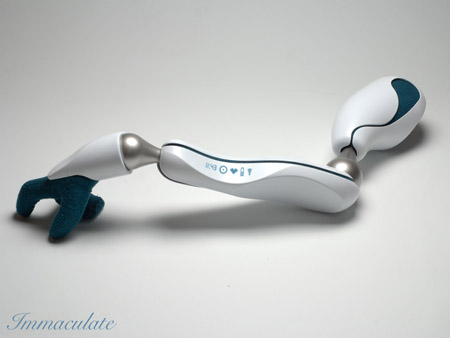The paper I am currently writing for Computers and Society
summarizes “Artificial Parts, Practical Lives,” a historical depiction of
prosthetic appendages and aesthetics that analyzes societal influences on the design
and implementation. The latter part of
my essay intends to focus on the current state of prosthetics and also on
future developments, along with their ethical and implications such as
replacing completely healthy appendages with beneficial prosthesis. I wish to explore this topic with the content
of this blog post.

It is quite amazing how far prosthetics come over the course
of history. Simple wooden peg legs and
metal hand hooks are now being replaced by state of the art appendages
controlled by nerve impulses and microprocessors. The introduction of new materials, such as
advanced plastics and carbon-fiber composites enhance make limbs lighter and stronger
while also allowing for easier manufacture.
Despite these recent breakthroughs, there are a few key issues that are
encumbering biomedical engineers, including the direct attachment of the
prosthetic to the patient’s bone, and the availability of prosthetic limbs in
both developed and developing countries.
A modern prosthetic limb can cost upwards of $100,000. Scientists and engineers are working on
methods to resolve such issues and progress is promising.
The largest area of development relative to prosthesis’s
long and complex history falls within the interface between the amputee’s stump
and the socket of the appendage. Current prosthesis incorporates silicon
elastomers that create a soft and slightly elastic inner liner. This provides more comfort and a compliant
barrier between the rigid prosthetic and the skin of the user. Carbon fiber is also being widely used as a
structural component due to its light weight and high strength. Flex-Foot, a prosthetic foot company founded
in the U.S. by amputee Van Phillips, use carbon fiber springs that store and
release energy upon impact and retraction and better emulate the physics of
biological motion.

Since the early 1990’s and the decades first artificial knee
with an “on board” computer, biomedical engineers have been incorporating microprocessors
into prosthetic appendages. Termed “intelligent
prostheses,” these high-tech limbs provide a more reliable gait pattern during
the swing phase of the gait cycle. The
Otto Bock C-Leg offers symmetry in the swing phase and also a greater security
in the stance phase by preventing unintentional buckling during standing. Sensors in the prosthetic record information
on the position of the leg in space and send that information to two microprocessors
in the knee. A hydraulic damper then
receives this information and is adjusted up to 50 times per second. Over 1000 C-Legs have been fitted to date,
and their innovative design has reached much success, however, these prosthetics can cost 4 times more than
the conventional limb replacements, decreasing overall availability.
Researchers are now trying to conquer the take of attaching artificial limbs directly to the bone of the patient. Attaching artificial teeth to the jaw bone, a similar concept, has been going on for decades and now the procedure developer, Per Branemark, is attempting to carry over his techniques to prosthetics. The stump is a dynamic body part that changes over time. This makes the fitting process very arduous and the comfort level of the prosthetic vary. With osseointegration, directly attaching the titanium implant to bone, fit is unaffected by the volume of the stump. Swedish physicians are conducting experiments in order to deem osseointegration fit for long term use.
A common theme in the advancement of prosthetics involves a
narrowing of the gap between the abled and disabled. This is occurring on levels of performance, as depicted above, and aesthetic quality. The same silicon coating that has been used for the socket of prosthetics is also being used as a lifelike external surface of the fixtures. Much work goes into matching the prosthetic limb to the intact limb, in color and symmetry. Expense is once again a factor as a custom made prosthetic skin can cost upwards of $3500 and requires replacement every few years.

Lower manufacturing costs, due to modern industrial fabrication and injection molded plastics, are closing the gab between social class and economic standing in terms of acquiring a prosthetic appendage. Red Cross is producing low cost polypropylene plastic prostheses, that can be assembled by the unskilled local workers, for areas where conflict or environmental catastrophes result in large amounts of amputations. Durability comes as a drawback for these low cost limbs.
The technological advancement of prostheses, especially over the past couple decades, has drastically improved the condition of the disabled and narrowed the gap between the abled and disabled. Some groups , however, believe that at this rate, individuals will not only be able to match the quality and functionality of biological limbs but also far surpass them in strength and dexterity. Ray Kurzweil, a large presence in the field of emerging technology, believes that sometime in the near future, patients will voluntarily want to have their biological limbs replaced by prosthetic ones. There are plenty of ethical concerns that accompany voluntary prosthetic replacement, with the major one being the unfair advantages given to those who can afford them. Once prostheses match the ability of their biological counterparts, will they keep advancing? If this is the case, there will be a gap opposite to the one we have right now between the abled and disabled. Those who don't want to upgrade their limbs or vital organs to technically advanced synthetic ones will now be the ones suffering from disabilities.
No comments:
Post a Comment